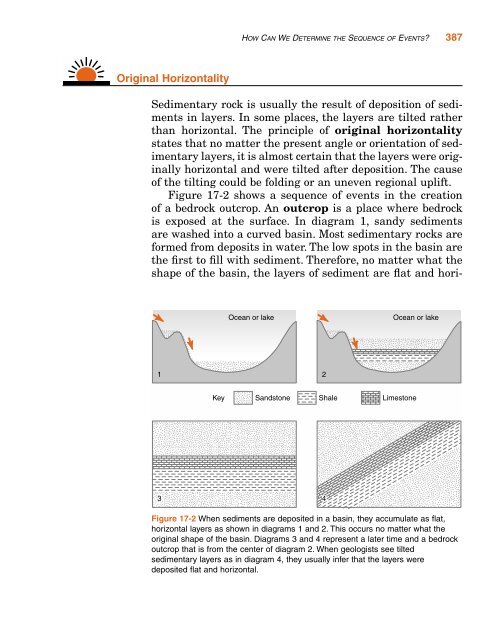Chapter 17 Unraveling Geologic History
Chapter 17 Unraveling Geologic History
Chapter 17 Unraveling Geologic History
You also want an ePaper? Increase the reach of your titles
YUMPU automatically turns print PDFs into web optimized ePapers that Google loves.
Original Horizontality<br />
HOW CAN WE DETERMINE THE SEQUENCE OF EVENTS? 387<br />
Sedimentary rock is usually the result of deposition of sediments<br />
in layers. In some places, the layers are tilted rather<br />
than horizontal. The principle of original horizontality<br />
states that no matter the present angle or orientation of sedimentary<br />
layers, it is almost certain that the layers were originally<br />
horizontal and were tilted after deposition. The cause<br />
of the tilting could be folding or an uneven regional uplift.<br />
Figure <strong>17</strong>-2 shows a sequence of events in the creation<br />
of a bedrock outcrop. An outcrop is a place where bedrock<br />
is exposed at the surface. In diagram 1, sandy sediments<br />
are washed into a curved basin. Most sedimentary rocks are<br />
formed from deposits in water. The low spots in the basin are<br />
the first to fill with sediment. Therefore, no matter what the<br />
shape of the basin, the layers of sediment are flat and hori-<br />
Figure <strong>17</strong>-2 When sediments are deposited in a basin, they accumulate as flat,<br />
horizontal layers as shown in diagrams 1 and 2. This occurs no matter what the<br />
original shape of the basin. Diagrams 3 and 4 represent a later time and a bedrock<br />
outcrop that is from the center of diagram 2. When geologists see tilted<br />
sedimentary layers as in diagram 4, they usually infer that the layers were<br />
deposited flat and horizontal.
















